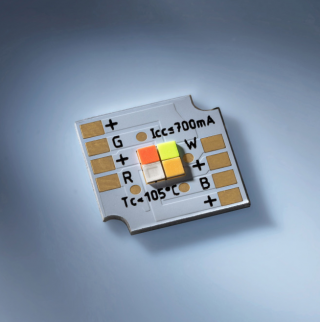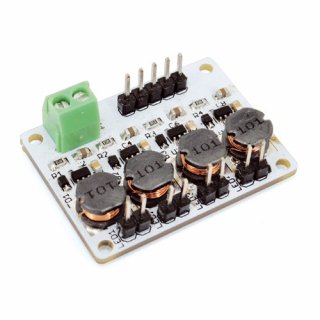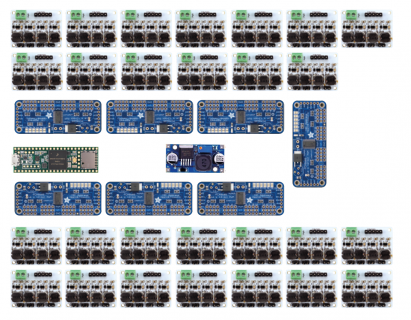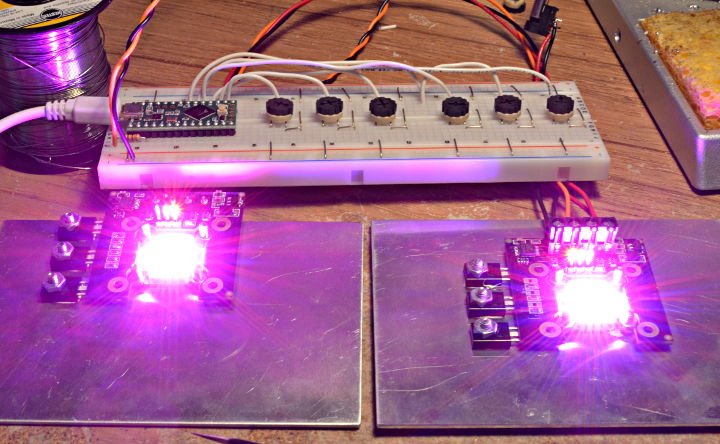Hi there,
I'm currently working on a project where I'd like to slowly fade the brightness of a series of high brightness RGBW LEDs.
Basically I'd like to drive these 4W (1W per channel) current-driven LEDs:

https://www.lumitronix.com/en_gb/smartarray-q4-led-module-4w-rgbw-4000k-cri-90-32454.html
What surprised me was that they only require 3V, and then I learned that with these types of high intensity LEDs, the voltage is not important, but the (consistency of the) current is.
I looked a long time for a suitable LED driver, and ended up buying one of these, which can take in 5-36V and provide a stable current.

https://store.open-electronics.org/colibri
Which also came with a long article explaining the usage of high intensity LEDs
https://www.open-electronics.org/colibri-driver-for-rgbw-leds/
Normally people use LED drivers in combination with a whole series of them. Though in my case, I want to drive 54 of them, in pairs of 2. (ie, 27 "unique" LEDs with each 4 channels (RGBW)).
The test setup I have works well:
- Teensy 3.5
- Adafruit 16 channel PWM https://www.adafruit.com/product/815 (going with this to have enough PWM pins to control all 27x4 channels)
- Colibri 4 channel PWM controlled LED driver
- 1x high intensity RGBW LED 4W
My main questions is, does anyone have experience with powering these types of LEDs? And are there alternatives to using the Colibri? I was surprised that there seems to be hardly anything out there. Especially something which can support more channels (there's a lot of single-channel LED drivers out there).

Above you can see my hardware setup, it seems crazy to need an LED driver per LED.
If anyone wonders why its important to have constant current, its to prevent the LEDs from flickering. Using an LED strip for my project is also not an option, each LED needs to sit at the end of a 2 meter cable and light up an acrylic rod.
Any help or suggestions would be greatly appreciated!
I'm currently working on a project where I'd like to slowly fade the brightness of a series of high brightness RGBW LEDs.
Basically I'd like to drive these 4W (1W per channel) current-driven LEDs:

https://www.lumitronix.com/en_gb/smartarray-q4-led-module-4w-rgbw-4000k-cri-90-32454.html
What surprised me was that they only require 3V, and then I learned that with these types of high intensity LEDs, the voltage is not important, but the (consistency of the) current is.
I looked a long time for a suitable LED driver, and ended up buying one of these, which can take in 5-36V and provide a stable current.

https://store.open-electronics.org/colibri
Which also came with a long article explaining the usage of high intensity LEDs
https://www.open-electronics.org/colibri-driver-for-rgbw-leds/
Normally people use LED drivers in combination with a whole series of them. Though in my case, I want to drive 54 of them, in pairs of 2. (ie, 27 "unique" LEDs with each 4 channels (RGBW)).
The test setup I have works well:
- Teensy 3.5
- Adafruit 16 channel PWM https://www.adafruit.com/product/815 (going with this to have enough PWM pins to control all 27x4 channels)
- Colibri 4 channel PWM controlled LED driver
- 1x high intensity RGBW LED 4W
My main questions is, does anyone have experience with powering these types of LEDs? And are there alternatives to using the Colibri? I was surprised that there seems to be hardly anything out there. Especially something which can support more channels (there's a lot of single-channel LED drivers out there).

Above you can see my hardware setup, it seems crazy to need an LED driver per LED.
If anyone wonders why its important to have constant current, its to prevent the LEDs from flickering. Using an LED strip for my project is also not an option, each LED needs to sit at the end of a 2 meter cable and light up an acrylic rod.
Any help or suggestions would be greatly appreciated!


